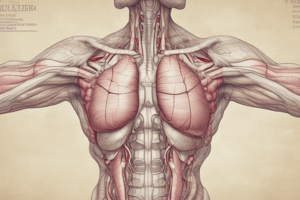Podcast
Questions and Answers
Where is the pituitary gland located?
Where is the pituitary gland located?
- At the top of the brain
- In the hypothalamus
- At the base of the brain, in the sella turcica (correct)
- In the thyroid gland
What is the main function of the anterior pituitary?
What is the main function of the anterior pituitary?
- To stimulate uterine contractions during childbirth
- To produce and regulate several hormones (correct)
- To store and release hormones produced by the hypothalamus
- To regulate growth and development
What hormone regulates thyroid gland function?
What hormone regulates thyroid gland function?
- Growth hormone
- Prolactin
- Thyroid-stimulating hormone (TSH) (correct)
- Adrenocorticotropic hormone (ACTH)
What is the function of vasopressin (ADH)?
What is the function of vasopressin (ADH)?
What structure controls the pituitary gland?
What structure controls the pituitary gland?
What is the result of a deficiency in vasopressin (ADH) production?
What is the result of a deficiency in vasopressin (ADH) production?
What is the term for a deficiency in one or more pituitary hormones?
What is the term for a deficiency in one or more pituitary hormones?
What is the term for a benign or malignant growth that can affect hormone production and overall health?
What is the term for a benign or malignant growth that can affect hormone production and overall health?
Flashcards are hidden until you start studying
Study Notes
Location and Structure
- Located at the base of the brain, in the sella turcica
- Weighs approximately 0.5 grams and measures 1 cm in diameter
- Composed of two main parts:
- Anterior pituitary (adenohypophysis): responsible for hormone production
- Posterior pituitary (neurohypophysis): stores and releases hormones produced by the hypothalamus
Functions
- Produces and regulates several hormones that control various bodily functions:
- Growth hormone: regulates growth and development
- Adrenocorticotropic hormone (ACTH): stimulates adrenal gland production of cortisol
- Thyroid-stimulating hormone (TSH): regulates thyroid gland function
- Prolactin: stimulates milk production in lactating women
- Oxytocin: stimulates uterine contractions during childbirth
- Vasopressin (ADH): regulates water reabsorption in the kidneys
- Acts as a relay between the hypothalamus and other endocrine glands to regulate hormone production
Regulation
- Controlled by the hypothalamus, which produces releasing and inhibiting hormones that stimulate or suppress pituitary hormone production
- Feedback mechanisms regulate hormone levels to maintain homeostasis
Disorders and Diseases
- Hypopituitarism: deficiency in one or more pituitary hormones
- Hyperpituitarism: excess production of one or more pituitary hormones
- Pituitary tumors: benign or malignant growths that can affect hormone production and overall health
- Diabetes insipidus: deficiency in vasopressin (ADH) production, leading to excessive thirst and urination
Overview of the Pituitary Gland
- Located at the base of the brain, in the sella turcica, weighing approximately 0.5 grams and measuring 1 cm in diameter
- Composed of two main parts: anterior pituitary (adenohypophysis) and posterior pituitary (neurohypophysis)
Functions of the Pituitary Gland
- Produces and regulates several hormones that control various bodily functions
- Hormones produced by the pituitary gland:
- Growth hormone: regulates growth and development
- Adrenocorticotropic hormone (ACTH): stimulates adrenal gland production of cortisol
- Thyroid-stimulating hormone (TSH): regulates thyroid gland function
- Prolactin: stimulates milk production in lactating women
- Oxytocin: stimulates uterine contractions during childbirth
- Vasopressin (ADH): regulates water reabsorption in the kidneys
- Acts as a relay between the hypothalamus and other endocrine glands to regulate hormone production
Regulation of the Pituitary Gland
- Controlled by the hypothalamus, which produces releasing and inhibiting hormones that stimulate or suppress pituitary hormone production
- Feedback mechanisms regulate hormone levels to maintain homeostasis
Pituitary Gland Disorders and Diseases
- Hypopituitarism: deficiency in one or more pituitary hormones
- Hyperpituitarism: excess production of one or more pituitary hormones
- Pituitary tumors: benign or malignant growths that can affect hormone production and overall health
- Diabetes insipidus: deficiency in vasopressin (ADH) production, leading to excessive thirst and urination
Studying That Suits You
Use AI to generate personalized quizzes and flashcards to suit your learning preferences.




